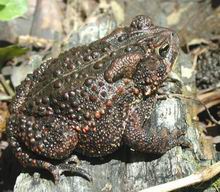July 11, 2006
American Toad. Bufo americanus

Scientific Name: Bufo americanus
Total Length: 2 – 4.5 inches
Range: The eastern half of North America, from central Canada to the southern states, but not reaching the Gulf coast.
Habitat: They may be found in habitats such as suburbs, gardens, heavily forested mountains, and places close to marshes, ponds, and temporary pools. They are often found under rocks and logs.
Sex Determination: Males are usually smaller than females and have darker, looser throats, especially during the mating season.
[snip left2][/snip] Reproduction: It takes place from March to July in shallow water. This is the only time they return to water. The males appear first and call for the females. The males often outnumber the females by as many as 5:1. The mating call is rather long and musical. Individual calls may last 6 – 30 seconds.
Males without mates are known for trying to mate with anything that moves, including mating pairs, other males, fish, drifting wood, and even a collector’s foot!
Once a male finds a female, he will grasp her around the waist and begin to mate. If the female is receptive, she will lay thousands of eggs in a double string. The eggs may be wrapped around aquatic plants or other objects in the water.
After spawning, the females usually leave the water immediately, while the males may stay for a few days in hope of mating with another female.
They are most likely to breed in an outdoor enclosure or an unheated greenhouse with a well planted pond.
Metamorphosis: The tadpoles swim in large schools and in a few weeks they develop into juvenile toadlets. They usually leave the water in mid to late summer, usually with the heavy rainfall.
Newly metamorphosed toads are most active during the day.
Larvae Care: Bring me to the Amphibian Larvae Care page!
Care In Captivity:
- Tank Size: A maximum of four toads in a 10 gallon tank would be alright.
- Substrate: Zoo Med’s Repti-Bark is our favorite substrate because it is easy to clean, creates more humidity, and is natural looking. Other substrates you can use are gravel, stones, cedar shavings, and soil.
- Decorations: You can have a log, bark, sticks, rocks, sphagnum moss, and fake plants in the tank. You can use live plants if you like, but you will have to replace them when they die.
- Water Bowl: We use a plastic lid from a plastic jar. Any shallow container can be used. If you want them to breed, make the tank half land and half water (an aqua-terrarium) with the water about 6 inches deep. You will also need a filter and a water thermometer.
- Tank Lid: You can have a flip top lid, a screen, or any other type of lid on the tank. There should be good ventilatiion.
- Heating: You can use a heat rock, a heating pad, or an electric blanket to heat the tank.
- Lighting: No additional lighting is needed but you may use a bulb with ultraviolet radiation if you want.
- Temperature/Humidity: The temperature should be 72 degrees F in the day and 54 degress F at night. In the winter, two months at 39-41 degrees F will stimulate hibernation. Doing this makes them healthier and encourages them to breed. You should have an air thermometer in the tank. It should have low humidity. You may use a humidity gauge which will show you how much humidity is in the tank.
- Feeding: The diet should have variety. Feed them crickets, earthworms, flies, moths, spiders, and other small invertebrates. They should all be sprinkled with vitamin and calcium supplements.
- Maintenance: Keep the tank clean and change the water bowl at least every other day. If you have an aqua-terrarium, change the filter fiber and ammo-carb in the filter when needed (about every 1.5 months).
Other Information: If well cared for, they are healthy if they remain in hiding during the day and appear only during feeding time. If they are restless and try to climb out of the tank, they are either hungry, thirsty, or unhealthy.
They adapt well to captivity and quickly become tame.
American Toads are usually confused for other toads. The following is the pyhsical traits of an American Toad:
- One or two large warts in each of the largest dark spots.
- Chest and forward part of abdomen usually spotted with dark pigment.
- Enlarged warts on the tibia.
- Paratoid gland is either separated from the ridge behind the eye, or connected with it by a short spur.
[snip center][/snip]
